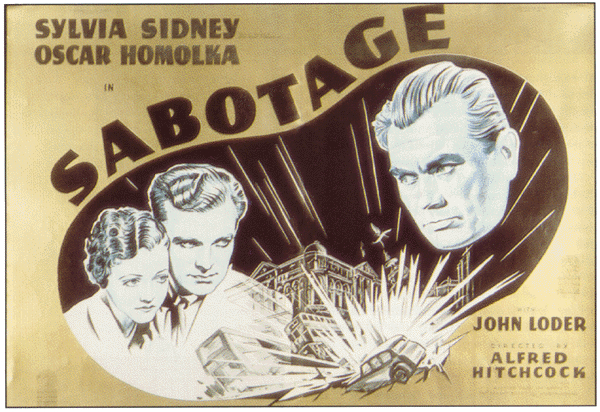The 1950s was such a rich decade in film that I found myself having a difficult time in selecting what films to eliminate. I could only select five films according to the blogathon rules of engagement. Once I narrowed my selection down the question or questions became how can you leave a film like Alfred Hitchcock’s North by Northwest off you list? How can you not select Sunset Blvd. or Some like it Hot or Strangers on a Train or The Searchers or High Noon or Paths of Glory or Singin’ in the Rain or Vertigo or On the Waterfront or Rio Bravo or well you get the point. The 1950s was a great decade. Narrow a select down to five favorites was not easy.
One rule I made on my own was to list a film director no more than once. Otherwise I could have listed five Alfred Hitchcock films: Vertigo, North by Northwest, Rear Window, Dial M for Murder and I Confess. Or I could have went with five Billy Wilder films: Some Like it Hot, Sunset Blvd, Ace in the Hole, Witness for the Prosecution and Stalag 17. I could also list five John Ford films but you get the point.
With that self set rule in place it became a little easier, however, I made one other rule. List a bunch of runner ups. Like I said the 1950’s was a rich decade. Anyway, here are my five favorite, not necessarily the bests, but favorites with a bit of an explanation followed by my runner ups.
Ace on the Hole

Manipulation, exploitation, opportunism, and hard-boiled vile, shaken, mixed and slammed into your guts by Billy Wilder. Ace in the Hole (aka The Big Carnival) is a lurid, take no prisoners portrait of the news media delivering a knock down nasty assault on journalism and the morbid character of the blood leeching public. No one is spared. A film made more than fifty years ago, yet more relevant today than ever. Opportunistic journalists pushing the limits of ethics is a recurring trend. The news media, in general has become more bipartisan and show business, making news more than reporting news objectively. So-called entertainment news shows, making “superstars” out of marginal personalities like Paris Hilton, the Kardasians on television almost ever night. Kirk Douglas’ Charlie Tatum would fit right in with today’s media world.
Rear Window

This is my favorite Hitchcock film, not an easy task in itself to select. It’s also one of my favorite films of all time. A permanent top-fiver on every list I ever made. It never gets bumped. Maybe not so surprisingly I have written about Rear Window twice before. Rear Window gets to the roots of movie watching, and still photography, for that matter. For anyone who is an avid film goer, it is no great revelation that watching movies is an extension of voyeurism; after all, what are we doing but looking into the lives of others. Observing, in a socially acceptable way, as opposed to peeping into the windows of neighbors or strangers. We are all, to an extent, curious to know what other people are doing, it’s human nature. However, most people can keep these voyeuristic tendencies limited to the socially accepted variety. Alfred Hitchcock was well aware of this trait in humans and he suckers us into compliance right from the beginning with the casting of James Stewart. Who better than Mr. Nice Guy, Mr. Straight Lace to lure you into peeping in on your neighbors and making you think there is nothing weird about it. You may not like hearing it but yes, if you like watching movies you are a voyeur! Rear Window is also smart, funny, tense, meticulous and intriguing. Oh yeah, there is the gorgeous looking Grace Kelly too, and the excellent Thelma Ritter.
invasion of the Body Snatchers

An allegory on the infiltration of communism in America? A metaphor for people turning a blind eye to the McCarthyism hysteria that was sweeping the country in the early 1950’s? An attack on the potential dangers of conformity and the stamping out of individuality? Don Siegel’s 1956 gem of a film, Invasion of the Body Snatchers, has been said to “really be about” any and all of these themes since its debut now more than fifty years ago. Siegel, who should know, never mentions any of this kind of subtext in his autobiography, A Siegel Film, so one can assume, all the reading into this classic SF film is just that, critics and film goers reading their own thoughts and ideas into a work of pop art. After all, isn’t personal interpretation one of the elements and joys of enjoying art?
Invasion of the Body Snatchers is an expertly made science fiction thriller that slowly builds in tension and never lets up. Filled with perfectly composed cinematography, a pulsating music score, by Carmen Dragon, and top notch acting performances from Kevin McCarthy and the lovely Dana Wynters, in a gallant battle to save the human race from dehumanizing pods.
Invasion of the Body Snatchers cautions us on the problem of being complacent with our lives; falling asleep is a danger, we are vulnerable, one loses touch with the world, and pods can quickly take us over. This fear is as relevant today as it was more than fifty years ago, maybe even more so, when the film was made, as pod like ideologues and followers swarm into the political mainstream.
Gun Crazy

The original title, Deadly Is The Female, says it all. A lethal woman and a chump of a guy whose life isn’t worth a plug nickel once the sexual sparks ignite and the bullets begin to fly. Gun Crazy is a compact, quick moving, finely tuned, low-budget piece of celluloid art. Brilliant in its minimalist approach, this small quickie accomplishes more visual beauty and excellent pacing than 99% of all high budget products that are excreted from today’s filmmakers. Note how director Joseph H. Lewis focuses entirely on the young lovers making all the other characters and their actions secondary. Even the police, as they close in on the couple in the swamp, are barely on-screen. The stunning bank robbery sequence, shot in one long take, sucks the audience, into the action practically making us all accessories in the crime.
Touch of Evil

The opening is one astounding continuous long running brilliant shot. It’s a spectacular beginning to one of the most interesting film noir’s ever made. Touch of Evil is also my own personal favorite Orson Welles work. It’s low budget film making that cannot be beat. Released on the top half of a twin bill, at least in New York, the film played at theaters around the city for only four days; scaled back to one theater for another three days and then quickly disappeared. Orson Welles as Hank Quinlan is an unkempt, overweight, beastly looking character. Visually, Welles made himself grotesque by placing the camera at a very low angles to emphasizes his character’s bulk. In one scene, we see Quinlan lifts he massive body up and out of a car, getting the full brunt of his size and hideous unkempt clothes right in our face. If there is a weak link in the film, it’s Charlton Heston playing Vargas, the Hispanic detective. Can anyone really believe Heston as Hispanic? Touch of Evil is a dark dirty, gritty noir.
Read more about the Five Favorite Films of the 50’s here!!!
And below are a few Runner Ups. I’m sure I missed a few.
Some Like it Hot
North by Northwest
Rio Bravo
Night of the Hunter
Strangers on a Train
The Asphalt Jungle
Paths of Glory
The Searchers
The Killing
Rio Bravo
Dial M for Murder
High Noon
Sunset Blvd.
Singin’ in the Rain
On the Waterfront
From Here to Eternity
Witness for the Prosecution
Vertigo
Rashomon
A Place in the Sun
Bridge on the Rive Kwai
12 Angry Men
Rififi
Pickup on South Street
















